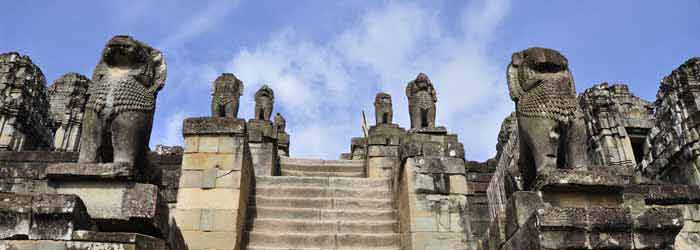
- Lao Tzu
Phnom Bakheng is the quintessential representation of a 'temple mountain', a temple built in the shape of mount Meru, which was the home of the gods in Hindu mythology. The temple lacks some of the archaological splendour which is still reminsiscent in other temples. Not because it never existed, but simply because the temple is in a poor state, being dedicated around 907AD. However it has historical significance, as it was the principal temple of the Angkor kingdom, being the most important of the Angkor temples in Yasovarman's new capital when he brought his court from the Roluos area.
Phnom Bakheng is very similar in style to the Bakong at Roluos, ascending square terraces with a temple sitting at the top of the 'mountain'. Only some of its banks are visible, but there once was a moat surrounding the temple. Four gopuras allowed access to the ascending steps, the most interesting is the east entrance where two lions guard the entrance. As you ascend, you realise the decrepit state of the towers.

View over the jungle from Phnom Bakheng
The outer temples are in ruins, and all that is left of the main tower is the outer shell, nevertheless some fine devata carvings are still visible. The sensation of reaching the top is wonderful as the views which await are spectacular, and they reinforce the feeling of importance that this temple had in the realm. Phnom Krom, the perimeter of Tonle Sap lake, the West Baray, and of course Angkor Wat can all be seen - it is a scene of spectacular beauty to catch these views during a clear sunset..
Cambodia travel information and Angkor Wat tour specialists ABOUTAsia are based in Siem Reap just 4km from Angkor Wat. At the heart of the organisation is a guiding research centre providing Cambodia vacation advice and industry leading tours planning.
Peerless service standards and local positioning have made us the tour operator of choice by international luxury travel groups and discerning independent travellers to Angkor Wat, Cambodia and Southeast Asia.